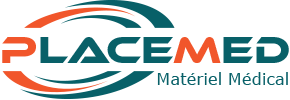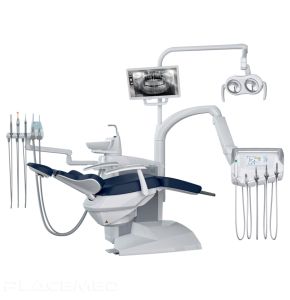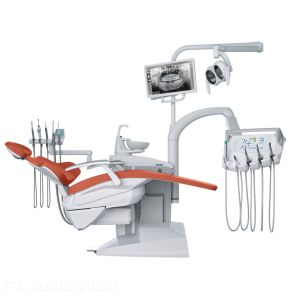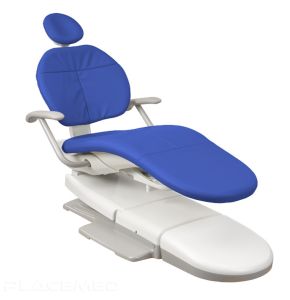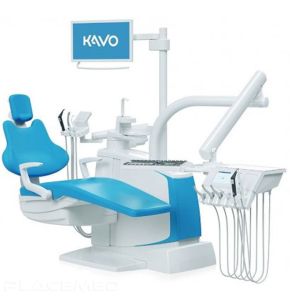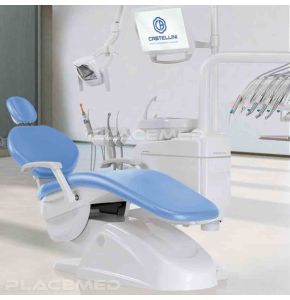Dental unit
Stern Weber S380TRC Dental Unit
Price on request18/11/2024 290
Dental Care Unit - Stern Weber S280TRC
Price on request18/11/2024 299
A-DEC 500 Dental Treatment Chair
Price on request18/11/2024 326
Dental Chair - Kavo ESTETICA E70/E80 Vision
Price on request18/11/2024 362
Dental treatment unit with light SKEMA 5
Price on request18/11/2024 262
The Dental Unit: The Heart of Excellence in Dental Care
The dental unit is a central element in any modern dental office. It brings together all the necessary equipment to provide quality dental care. At Placemed, we offer a wide range of dental units to meet the needs of professionals committed to dental excellence.
Components of the Dental Unit
The dental unit consists of several key elements. The patient chair is designed to provide comfort and stability during treatments. It is often paired with a Kavo dental chair , renowned for its quality and ergonomics. The practitioner unit includes essential instruments such as turbines, scalers, and polymerizing lamps. The aspiration system is also integrated to keep the patient's mouth clean and dry during procedures.
This centralization of equipment in the dental unit allows the practitioner to work efficiently and safely. It facilitates workflow and offers the essential freedom of movement needed to perform quality dental care.
Technological Innovations
Dental units have evolved significantly thanks to technological innovations. Digital units now integrate digital imaging and management software. This allows the practitioner to access X-rays and patient records directly on an touchscreen that is easily accessible. Models like the Kavo Estetica or the Estetica E70/E80 Vision are at the forefront of technology.
Advanced ergonomics is also a priority. Dental units are designed to provide optimal comfort for both the practitioner and the patient. They allow for a natural working position, reducing fatigue and improving the precision of movements. Freedom of movement is thus guaranteed, which is essential for complex treatments.
Customization
Each dental office has specific needs. That is why the dental unit can be customized through modular configurations. Whether for orthodontics, implantology, or periodontology, it is possible to adapt the unit to the practitioner's specialties. The mobile dental unit is, for example, ideal for home visits or in rural areas.
There are numerous instrumentation options. You can choose between different turbines, scalers, or polymerizing lamps to meet the demands of dental care. Models like the Primus 1058 Life offer advanced technical specifications for optimal performance.
Maintenance and Hygiene
Hygiene is paramount in a dental office. Dental units are equipped with integrated disinfection systems to prevent cross-infections. Intensive decontamination of water circuits and instruments is facilitated by automated programs. This ensures a safe environment for both the patient and the practitioner.
Preventive maintenance is essential to extend the lifespan of the equipment. Regular checks and adherence to the manufacturer's recommendations ensure that the unit remains in perfect working condition. A well-maintained unit ensures consistent performance and maximum safety.
Standards and Certifications
Dental units must comply with strict standards to ensure the safety and quality of care. Regulatory compliance with CE and ISO standards is essential. This ensures that the unit meets European requirements for electrical and mechanical safety.
Reputable manufacturers like Kavo offer made in Europe dental units, meeting the highest quality standards. The technical specifications are designed to provide reliable and durable performance, thereby ensuring practitioners' trust.
The dental unit is much more than just equipment. It is the central pillar of the dental office, essential for providing quality dental care. Thanks to technological innovations, customization, and adherence to standards, it contributes to dental excellence . At Placemed, discover a selection of dental units tailored to your needs, whether it's a mobile dental unit or a high-end model like the Kavo dental chair. Investing in a high-performance dental unit means investing in patient satisfaction and the success of your practice.
 Francais
Francais 